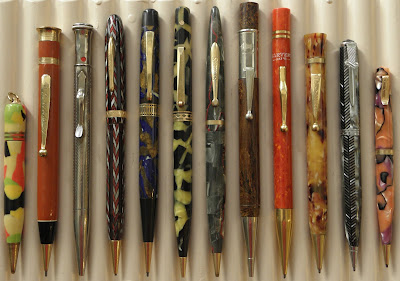This article has been edited and included in The Leadhead's Pencil Blog Volume 4; copies are available print on demand through Amazon here, and I offer an ebook version in pdf format at the Legendary Lead Company here.
If you don't want the book but you enjoy this article, please consider supporting the Blog project here.
A while back, the subject of Dunn pens came up on Facebook, and I felt compelled to take a family portrait of the examples in my collection:
That bottom one was missing the cap, by the way. These came in a nice range of patterns:
Each is marked on the cap with simply the words “Dunn / Pat. Pend.”:
Looking at these pencils got me to thinking again, about how much they resemble another early repeating pencil – the Selfeed:
Selfeeds – at least all of the ones I’ve seen – are marked “Selfeed / Pat. Appl. For,” and they have very similar caps, with just a bit of added embellishment:
In 2011, I had noted the similarities between the two brands in The Catalogue; but I had also attributed the Selfeed to the Kemper Thomas Company based on an instruction sheet for the Selfeed I had found. I’ve since debunked the Kemper Thomas connection myself in an article I wrote a year later (see
http://leadheadpencils.blogspot.com/2012/11/one-wild-goose-chase.html), in which I wrote how the Selfeed was the product of the Selfeed Pencil Company, Inc., which had been established on Decmeber 21, 1925 by the Wall-Stieh Company, a pen company which set up the subsidiary to market and sell the company’s pencils. Daniel Kirchheimer had turned up an advertisement from May, 1925, in which Wall-Stieh’s “new” pencils were introduced.
I have finally tracked down the trademark registration for the Selfeed mark, which claims a date of first use of April 15, 1924:
The timing fits perfectly into the Dunn story. The Dunn Pen was introduced in 1921, and while the company advertised heavily, there’s no mention of the company producing (that’s “producing,” not manufacturing) pencils through 1924, when the company failed. Since Teddy Roosevelt’s son, Kermit Roosevelt, was on the company’s board of directors, his examination by the bankruptcy trustee was big news in early April, 1925:
John Gerdes, President of the newly formed Dunn Pen and Pencil, Inc., was quick to do damage control, announcing that the newly reorganized Dunn Pen and Pencil had nothing to do with the failed Dunn Pen Company.
As a side note, this leads me to correct something in the Pen Collectors of America’s library: the Dunn brochure in its library is attributed with a date of 1920, but since the letter which accompanies it is from John Gerdes as President of Dunn Pen and Pencil, we know it could not be earlier than May, 1924. The letterhead also lists other officers: James H. Scarr, Vice President, C.B. Bentz, Secretary and Walter S. Rockwell, Treasurer:
It is only after Dunn Pen and Pencil rises from the ashes of the Dunn Pen Company that there is any mention of pencils being offered. There’s a page in the PCA Library’s brochure which shows them:
The new management faced a dilemma in reorganizing: the single greatest asset they acquired from the Dunn Pen Company was the brand name recognition of the company’s pen, but the financial misdealings of the predecessor firm left the name tarnished. Whether the reputation of the name “Dunn” was irreparably damaged during the bankruptcy proceedings, or whether the new management was no more capable than the old, the new venture appears to have been as unsuccessful as the earlier one – by late 1925, Dunn pencils were being blown out at discounts, advertised not in the New York press, but in the
Philadelphia Inquirer:
Note that this advertisement ran in the October 16, 1925 issue of the
Inquirer, and remember that the Selfeed Pencil Company was established by Wall-Stieh on December 21, 1925. And there’s another detail in this advertisement which, even accounting for a bit of artistic license in the drawings, I consider important to this story. Look closely at the clip:
That’s not the flat clip of a Dunn pencil, as seen on all of the surviving examples I’ve seen as well as in the Dunn catalog at the PCA Library. That’s the ball clip you’ll see on every example of a Selfeed:
After 1925, it appears Dunn Pen and Pencil winds up and goes out of business; advertisements after that date are discounted and discontinued blowouts of the company’s pens.
When I string all of these clues together and overlay the history of the Dunn Pen Company, Dunn Pen and Pencil, Inc. and Wall-Stieh together, the complete story floats to the surface:
1. The Wall-Stieh Company, founded in the late teens, develops a new repeating pencil in early 1924, which it begins marketing as the “Selfeed” on April 15, 1924.
2. The Dunn Pen Company, which only made fountain pens, fails in April, 1924.
3. Dunn Pen and Pencil, Inc. buys all of the assets of the discredited Dunn Pen Company. In order to better capitalize on the market (and differentiate itself from its tarnished predecessor), the new company decides to offer a companion pencil with its pens. The new company has no means to make one of its own and there is no evidence that it ever tried.
4. Dunn Pen and Pencil, Inc. contracts with the Wall-Stieh company to supply the new company with Selfeed pencils, made with plain caps and stamped with the Dunn name, sometime during 1924 or early 1925.
5. The added production demand causes Wall-Stieh to set up the Selfeed Pencil Company to manufacture pencils on its own account as well as to supply Dunn in December, 1925 – just as Dunn Pen and Pencil folds.





















































